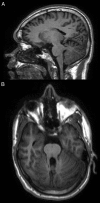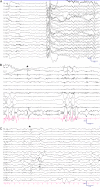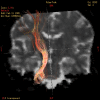Uncrossed epileptic seizures in Joubert syndrome
- PMID: 26002775
- PMCID: PMC4442200
- DOI: 10.1136/bcr-2014-207719
Uncrossed epileptic seizures in Joubert syndrome
Abstract
Joubert syndrome and related disorders comprise a subgroup of ciliopathies defined by the presence of the 'molar tooth sign', a midbrain-hindbrain malformation identifiable by neuroimaging. Characteristically, the corticospinal tract and superior cerebellar peduncles do not decussate. Epileptic seizures are uncommon. We present a case of a 28-year-old man with a background of Leber's congenital amaurosis with nephronophthisis, requiring kidney transplantation, and mental retardation, who developed epileptic seizures consisting of a short muffled cry and involuntary shaking movements of the extremities beginning in the left upper limb; these episodes lasted several seconds and occurred in clusters. Simultaneous video-EEG recording showed an ictal pattern in the left frontal lobe. Brain MRI revealed the pathognomonic 'molar tooth sign'; diffusion tensor imaging (DTI)-tractography showed a lack of decussation of both corticospinal tracts. To the best of our knowledge, this is the first time that DTI-tractography has been used to uncover the anatomical substrate underlying the semiology of epileptic seizures.
2015 BMJ Publishing Group Ltd.
Figures




Similar articles
-
High-Resolution Diffusion Tensor Imaging and Tractography in Joubert Syndrome: Beyond Molar Tooth Sign.Pediatr Neurol. 2015 Jul;53(1):47-52. doi: 10.1016/j.pediatrneurol.2015.02.027. Epub 2015 Mar 5. Pediatr Neurol. 2015. PMID: 25890865
-
[Sign of the « molar tooth »: characteristic MRI appearance of Joubert syndrome].Pan Afr Med J. 2015 Oct 13;22:127. doi: 10.11604/pamj.2015.22.127.7971. eCollection 2015. Pan Afr Med J. 2015. PMID: 26889308 Free PMC article. French. No abstract available.
-
Tecto-cerebellar dysraphism with occipital encephalocele: not a distinct disorder, but part of the Joubert syndrome spectrum?Neuropediatrics. 2011 Aug;42(4):170-4. doi: 10.1055/s-0031-1287763. Epub 2011 Sep 19. Neuropediatrics. 2011. PMID: 21932183
-
Joubert syndrome and related disorders.Handb Clin Neurol. 2013;113:1879-88. doi: 10.1016/B978-0-444-59565-2.00058-7. Handb Clin Neurol. 2013. PMID: 23622411 Review.
-
Healthcare recommendations for Joubert syndrome.Am J Med Genet A. 2020 Jan;182(1):229-249. doi: 10.1002/ajmg.a.61399. Epub 2019 Nov 11. Am J Med Genet A. 2020. PMID: 31710777 Free PMC article. Review.
Cited by
-
An Atypical Presentation of Joubert Syndrome Due to a Novel Mutation in ZNF423 Gene.J Pediatr Neurosci. 2020 Jul-Sep;15(3):294-296. doi: 10.4103/jpn.JPN_168_19. Epub 2020 Nov 6. J Pediatr Neurosci. 2020. PMID: 33531950 Free PMC article.
-
Incomplete hippocampal inversion in patients with mutations in genes involved in sonic hedgehog signaling.Heliyon. 2023 Mar 21;9(4):e14712. doi: 10.1016/j.heliyon.2023.e14712. eCollection 2023 Apr. Heliyon. 2023. PMID: 37012904 Free PMC article.
-
Genetic regulation of gene expression in the epileptic human hippocampus.Hum Mol Genet. 2017 May 1;26(9):1759-1769. doi: 10.1093/hmg/ddx061. Hum Mol Genet. 2017. PMID: 28334860 Free PMC article.
References
Publication types
MeSH terms
Supplementary concepts
LinkOut - more resources
Full Text Sources
Other Literature Sources
Medical
